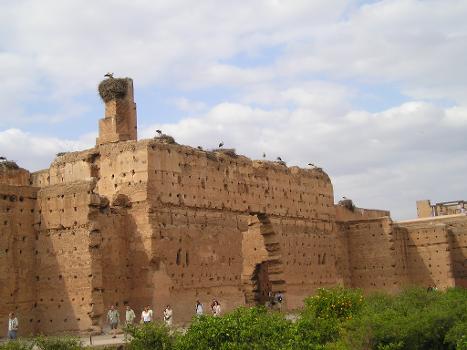General Information
Project Type
| Function / usage: |
Castle |
|---|
Location
| Location: |
Marrakech, Marrakesh-Safi, Morocco |
|---|---|
| Coordinates: | 31° 37' 6" N 7° 59' 9" W |
Technical Information
There currently is no technical data available.
Excerpt from Wikipedia
El Badi Palace (Arabic: قصر البديع, meaning Palace of the Creator of Wonder or Palace of Wonder; also anglicized as the Badic Palace) is a ruined palace located in Marrakesh, Morocco. It was commissioned by the sultan Ahmad al-Mansur of the Saadian dynasty sometime shortly after his accession in 1578. The palace's construction was funded by a substantial ransom paid by the Portuguese after the Battle of the Three Kings. It is currently a popular tourist attraction.
Construction and design
The palace took fifteen years to build, with construction finally completed around 1593 and was a lavish display of the best craftmanship of the Saadian period. Constructed using some of the most expensive materials of the time, including gold and onyx, the colonnades are said to be constructed from marble exchanged with Italian merchants for their equivalent weight in sugar. The original building is thought to have consisted of 360 richly decorated rooms, a courtyard (135×110 m) and a central pool (90×20 m).
Marrakech and El Badi Palace, by Adriaen Matham, 1640There are several large pavilions on the site, which are believed to have been used as summer houses. The largest on the site is known in Arabic as a l-Quba al-Khamsiniya (القُبة الَخْمسينية), which translates into 'The Fifty Pavilion', named either after ist surface area of some 50 cubits or the fact that it once contained 50 columns. "Al-Quba al-Khamsiniya" is also the title of a poem by Abd al-Aziz al-Fishtali, poet laureate of Sultan Ahmed al-Mansur's court. The site also includes several stables and dungeons.
Decline
After the fall of the Saadians and the rise of the Alaouite dynasty, the palace entered a period of rapid decline. Sultan Ismail Ibn Sharif stripped the building of ist contents, building materials and decorations, to be used in the construction of his new palace in his new capital at Meknes.
Today
The palace today is a well known tourist attraction. The complex contains a museum, with exhibits such as a restored 12th-century minbar that once stood in the Koutoubia Mosque.
For a number of years the Marrakesh Folklore Festival has taken place within the palace.
Text imported from Wikipedia article "El Badi Palace" and modified on 23 July 2019 under the CC-BY-SA 3.0 license.
Participants
Currently there is no information available about persons or companies having participated in this project.
Relevant Web Sites
- About this
data sheet - Structure-ID
20048614 - Published on:
09/10/2009 - Last updated on:
28/05/2021





